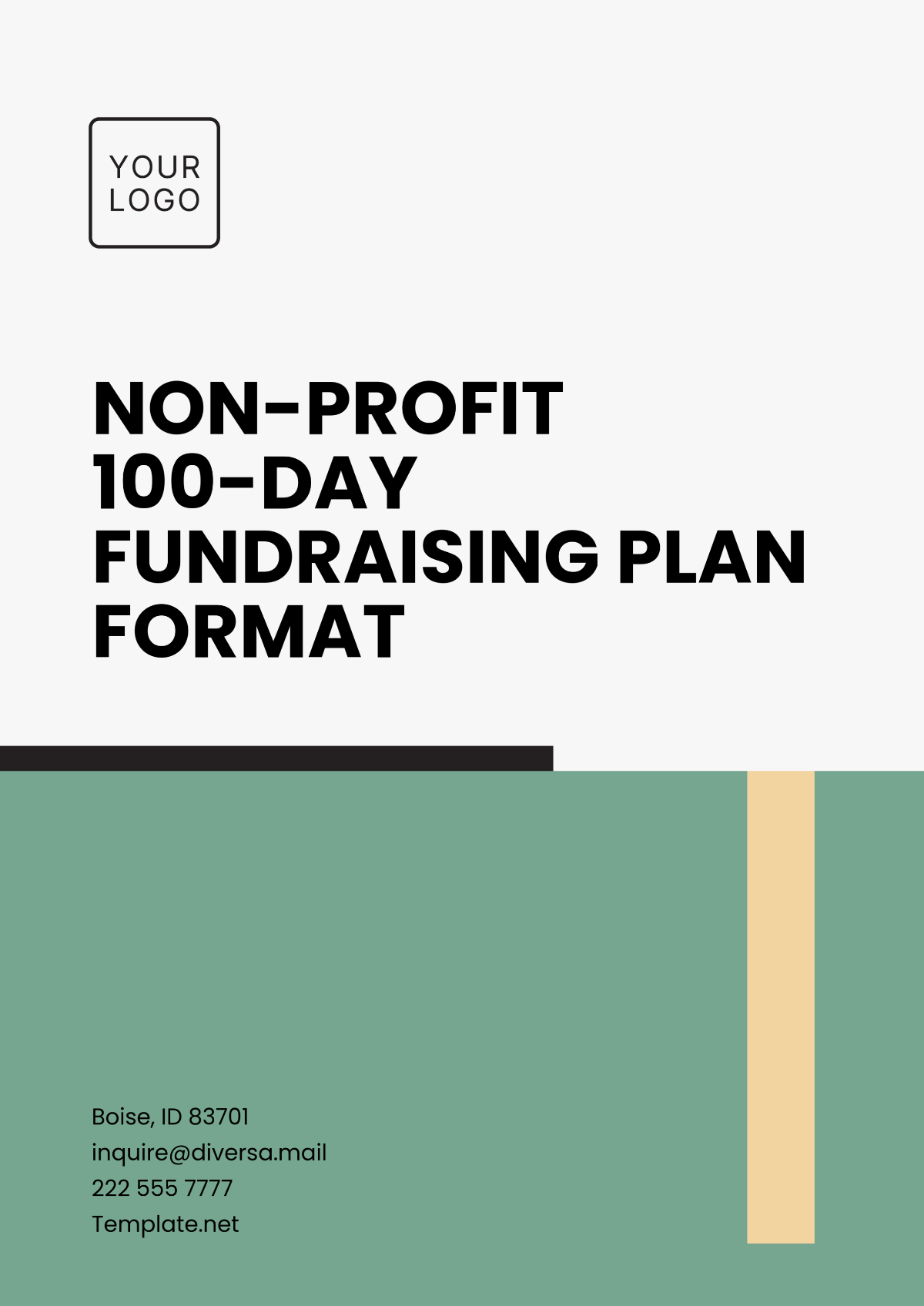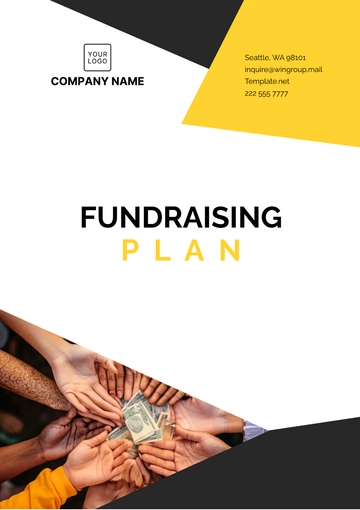Free Non-Profit 100-Day Fundraising Plan Format

Prepared by:
[Your Name]
[Your Company Name]
Introduction
Purpose of the Plan: Clearly state the goal of the fundraising efforts over the next 100 days, including the financial target and the mission it supports.
Overview of the Organization: Briefly describe the non-profit organization, its mission, and its target audience.
Phase 1: Preparation (Days 1-20)
Goal Setting and Strategy Development
Define the fundraising goal (e.g., $100,000).
Identify target donors (individuals, foundations, corporate partners).
Determine the fundraising channels (events, online campaigns, grants).
Team Mobilization
Assign roles and responsibilities (e.g., campaign managers, donor relations team).
Set up a team communication plan for efficient collaboration.
Platform and Tools Setup
Select online donation platforms and tools.
Prepare digital and physical materials (flyers, donation pages, social media assets).
Research and Engagement
Identify key potential donors and partners.
Begin outreach with personalized engagement (phone calls, emails).
Phase 2: Fundraising Launch (Days 21-60)
Kickoff Event
Plan and host an event to launch the campaign (virtual or in-person).
Ensure press coverage and social media promotion to maximize visibility.
Donor Outreach and Engagement
Reach out to top donors for initial contributions.
Regularly update the donor community on campaign progress.
Promote via email newsletters, social media, and the organization's website.
Engage Corporate Sponsors
Reach out to potential corporate sponsors for matching gifts or large donations.
Offer visibility and marketing benefits in return for sponsorship.
Mid-Campaign Review
Evaluate progress toward goals and adjust strategies if necessary.
Analyze donor engagement and campaign reach.
Phase 3: Intensification (Days 61-90)
Donor Stewardship
Continue personalized outreach to existing donors to secure additional contributions.
Highlight specific needs or projects the donations will support.
Special Campaigns
Launch themed campaigns or limited-time challenges to boost donations (e.g., a 24-hour challenge with matching funds).
Encourage peer-to-peer fundraising efforts from supporters.
Community Engagement
Host virtual or in-person community events to raise awareness.
Collaborate with local influencers or community leaders for further reach.
Phase 4: Final Push and Wrap-Up (Days 91-100)
Final Campaign Surge
Promote a final push with a sense of urgency (e.g., “last chance” appeals).
Offer matching gift opportunities for donors to maximize contributions.
Thank-You Campaign
Send personalized thank-you notes to all donors and stakeholders.
Highlight the impact of the donations and how they will support the mission.
Celebrate Success
Celebrate reaching fundraising goals (or progress made) through an online or in-person event.
Share success stories, testimonials, and a final report on the funds raised.
Conclusion
Campaign Evaluation
Assess the success of the campaign in terms of financial goals, engagement, and donor retention.
Identify areas for improvement for future fundraising efforts.
Next Steps
Plan for long-term donor stewardship and future campaigns.
Continue communication with donors and supporters to build lasting relationships.
Contact Information
Provide key contacts within the organization for donor inquiries, follow-up, and next steps.
- 100% Customizable, free editor
- Access 1 Million+ Templates, photo’s & graphics
- Download or share as a template
- Click and replace photos, graphics, text, backgrounds
- Resize, crop, AI write & more
- Access advanced editor
The Non-Profit 100-Day Fundraising Plan Format Template from Template.net is an editable and customizable tool designed to enhance your fundraising efforts. Fully editable in our Ai Editor Tool, this template allows you to tailor strategies, set fundraising goals, and track progress, ensuring a structured and effective approach to meeting your non-profit’s financial targets.
You may also like
- Finance Plan
- Construction Plan
- Sales Plan
- Development Plan
- Career Plan
- Budget Plan
- HR Plan
- Education Plan
- Transition Plan
- Work Plan
- Training Plan
- Communication Plan
- Operation Plan
- Health And Safety Plan
- Strategy Plan
- Professional Development Plan
- Advertising Plan
- Risk Management Plan
- Restaurant Plan
- School Plan
- Nursing Home Patient Care Plan
- Nursing Care Plan
- Plan Event
- Startup Plan
- Social Media Plan
- Staffing Plan
- Annual Plan
- Content Plan
- Payment Plan
- Implementation Plan
- Hotel Plan
- Workout Plan
- Accounting Plan
- Campaign Plan
- Essay Plan
- 30 60 90 Day Plan
- Research Plan
- Recruitment Plan
- 90 Day Plan
- Quarterly Plan
- Emergency Plan
- 5 Year Plan
- Gym Plan
- Personal Plan
- IT and Software Plan
- Treatment Plan
- Real Estate Plan
- Law Firm Plan
- Healthcare Plan
- Improvement Plan
- Media Plan
- 5 Year Business Plan
- Learning Plan
- Marketing Campaign Plan
- Travel Agency Plan
- Cleaning Services Plan
- Interior Design Plan
- Performance Plan
- PR Plan
- Birth Plan
- Life Plan
- SEO Plan
- Disaster Recovery Plan
- Continuity Plan
- Launch Plan
- Legal Plan
- Behavior Plan
- Performance Improvement Plan
- Salon Plan
- Security Plan
- Security Management Plan
- Employee Development Plan
- Quality Plan
- Service Improvement Plan
- Growth Plan
- Incident Response Plan
- Basketball Plan
- Emergency Action Plan
- Product Launch Plan
- Spa Plan
- Employee Training Plan
- Data Analysis Plan
- Employee Action Plan
- Territory Plan
- Audit Plan
- Classroom Plan
- Activity Plan
- Parenting Plan
- Care Plan
- Project Execution Plan
- Exercise Plan
- Internship Plan
- Software Development Plan
- Continuous Improvement Plan
- Leave Plan
- 90 Day Sales Plan
- Advertising Agency Plan
- Employee Transition Plan
- Smart Action Plan
- Workplace Safety Plan
- Behavior Change Plan
- Contingency Plan
- Continuity of Operations Plan
- Health Plan
- Quality Control Plan
- Self Plan
- Sports Development Plan
- Change Management Plan
- Ecommerce Plan
- Personal Financial Plan
- Process Improvement Plan
- 30-60-90 Day Sales Plan
- Crisis Management Plan
- Engagement Plan
- Execution Plan
- Pandemic Plan
- Quality Assurance Plan
- Service Continuity Plan
- Agile Project Plan
- Fundraising Plan
- Job Transition Plan
- Asset Maintenance Plan
- Maintenance Plan
- Software Test Plan
- Staff Training and Development Plan
- 3 Year Plan
- Brand Activation Plan
- Release Plan
- Resource Plan
- Risk Mitigation Plan
- Teacher Plan
- 30 60 90 Day Plan for New Manager
- Food Safety Plan
- Food Truck Plan
- Hiring Plan
- Quality Management Plan
- Wellness Plan
- Behavior Intervention Plan
- Bonus Plan
- Investment Plan
- Maternity Leave Plan
- Pandemic Response Plan
- Succession Planning
- Coaching Plan
- Configuration Management Plan
- Remote Work Plan
- Self Care Plan
- Teaching Plan
- 100-Day Plan
- HACCP Plan
- Student Plan
- Sustainability Plan
- 30 60 90 Day Plan for Interview
- Access Plan
- Site Specific Safety Plan










